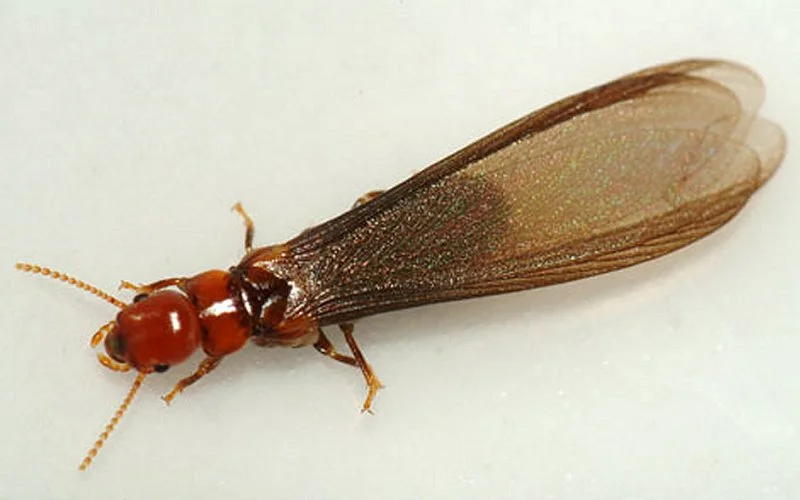If you have lived in the Pacific Northwest long enough to experience the rainy season, you know it brings several months of regular drizzling. This often results in water damage to susceptible wood, such as roofs and porches. Washington is home to pests that specifically target water-damaged wood, known as Secondary Wood Destroying Organisms. These insects are only interested in rotting wood and other potential food sources, like fungus. In contrast, Primary Wood Destroying Organisms, like Carpenter Ants, nest in sound wood.
In this article, we’ll cover:
- Identification, Behaviors, and Habits
- Dampwood Termites
- Moisture Ants
- Treatment
- Prevention
Identification, Behaviors, and Habits
Pacific Dampwood Termites
Dampwood Termites are the largest termite species in Washington. Winged termites may exceed 1 inch in length and are cream-colored to dark brown. Soldiers have large red-brown or black heads and cream-colored bodies, measuring about ¾ inch in length.

(Image of a Dampwood Termite)
This species has a caste system consisting of queens, kings, and soldiers, but no worker caste. Instead, nymphs and soldiers perform necessary worker functions. Dampwood Termites seek out damp wood, thriving in conditions caused by leaky plumbing, clogged gutters, or decaying stumps around your property. Swarming may occur on warm evenings in late summer or early autumn, especially after rain.
Moisture Ants
Moisture Ants are yellow to reddish-brown and are monomorphic, meaning they are all the same size. These ants are typically found in decayed wood, such as logs or stumps, and infest water-damaged wood.

(Image of Moisture Ants)
While they do not consume the wood they infest, they create galleries that produce a wet, sawdust-like substance known as frass, which resembles coffee grounds. Moisture Ants also tend aphids for honeydew and may enter homes in search of food.
Treatment
Due to their sensitivity to chemicals, DIY treatments for these insects are not advised. Attempts to treat moisture ants or dampwood termites with store-bought sprays can lead to them splitting their colony and relocating rather than being eliminated.
While you might notice a decrease in activity initially, ants may reappear in different areas of your home. It's crucial to reach out to a licensed pest control professional who can use effective techniques tailored to address the infestation directly.
Prevention
To effectively prevent infestations, address leaks and issues promptly. Regularly inspect your home for:
- Faulty grades
- Clogged gutters
- Leaks
- Areas where water may pool
At Sunrise Pest Management, we offer a comprehensive maintenance service called All Pest Protection. This quarterly service aims to prevent infestations from various pests, including ants, rodents, wasps, and spiders.
Our service includes:
- Exterior perimeter spray
- Spot treatment around doors and windows
- Web sweeps and egg sac removals
- Rodent bait stations to mitigate outside rodent populations
Each quarterly service is only $109 before tax, and if you encounter an infestation of fleas, bees, or spiders covered under your warranty, we’ll dispatch a technician for pest-specific treatment at no additional cost.
Contact Sunrise Pest Management
For tailored pest control solutions and comprehensive prevention methods, contact Sunrise Pest Management today for a complimentary quote. Protect your home from moisture ants and dampwood termites effectively.



Comments (0)
Thanks for your comment!
Thanks for your feedback! Your comments have been successfully submitted! Please note, all comments require admin approval prior to display.
Error submitting comment!
There is a problem with your comment, please see below and try again.